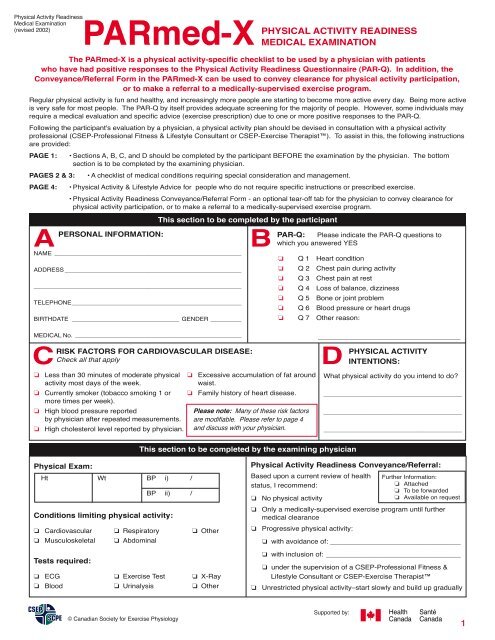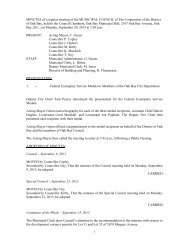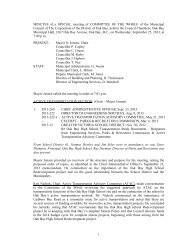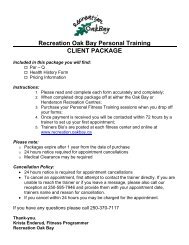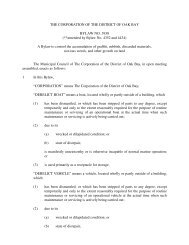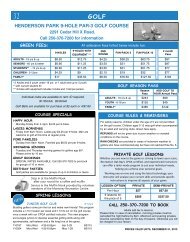PARmed-X
ParMed-X Form - The District of Oak Bay
ParMed-X Form - The District of Oak Bay
You also want an ePaper? Increase the reach of your titles
YUMPU automatically turns print PDFs into web optimized ePapers that Google loves.
Physical Activity Readiness<br />
Medical Examination<br />
<strong>PARmed</strong>-X<br />
(revised 2002)<br />
PHYSICAL ACTIVITY READINESS<br />
MEDICAL EXAMINATION<br />
The <strong>PARmed</strong>-X is a physical activity-specific checklist to be used by a physician with patients<br />
who have had positive responses to the Physical Activity Readiness Questionnaire (PAR-Q). In addition, the<br />
Conveyance/Referral Form in the <strong>PARmed</strong>-X can be used to convey clearance for physical activity participation,<br />
or to make a referral to a medically-supervised exercise program.<br />
Regular physical activity is fun and healthy, and increasingly more people are starting to become more active every day. Being more active<br />
is very safe for most people. The PAR-Q by itself provides adequate screening for the majority of people. However, some individuals may<br />
require a medical evaluation and specific advice (exercise prescription) due to one or more positive responses to the PAR-Q.<br />
Following the participant's evaluation by a physician, a physical activity plan should be devised in consultation with a physical activity<br />
professional (CSEP-Professional Fitness & Lifestyle Consultant or CSEP-Exercise Therapist). To assist in this, the following instructions<br />
are provided:<br />
PAGE 1:<br />
PAGES 2 & 3:<br />
PAGE 4:<br />
A<br />
PERSONAL INFORMATION:<br />
NAME ______________________________________________________<br />
ADDRESS ___________________________________________________<br />
____________________________________________________________<br />
TELEPHONE_________________________________________________<br />
BIRTHDATE _______________________________ GENDER _________<br />
MEDICAL No. ________________________________________________<br />
C<br />
• Sections A, B, C, and D should be completed by the participant BEFORE the examination by the physician. The bottom<br />
section is to be completed by the examining physician.<br />
• A checklist of medical conditions requiring special consideration and management.<br />
• Physical Activity & Lifestyle Advice for people who do not require specific instructions or prescribed exercise.<br />
• Physical Activity Readiness Conveyance/Referral Form - an optional tear-off tab for the physician to convey clearance for<br />
physical activity participation, or to make a referral to a medically-supervised exercise program.<br />
RISK FACTORS FOR CARDIOVASCULAR DISEASE:<br />
Check all that apply<br />
Less than 30 minutes of moderate physical<br />
activity most days of the week.<br />
Currently smoker (tobacco smoking 1 or<br />
more times per week).<br />
High blood pressure reported<br />
by physician after repeated measurements.<br />
High cholesterol level reported by physician.<br />
This section to be completed by the participant<br />
B<br />
Excessive accumulation of fat around<br />
waist.<br />
Family history of heart disease.<br />
Please note: Many of these risk factors<br />
are modifiable. Please refer to page 4<br />
and discuss with your physician.<br />
PAR-Q: Please indicate the PAR-Q questions to<br />
which you answered YES<br />
<br />
<br />
<br />
<br />
<br />
<br />
<br />
Q 1 Heart condition<br />
Q 2 Chest pain during activity<br />
Q 3 Chest pain at rest<br />
Q 4 Loss of balance, dizziness<br />
Q 5 Bone or joint problem<br />
Q 6 Blood pressure or heart drugs<br />
Q 7 Other reason:<br />
____________________________________<br />
D<br />
PHYSICAL ACTIVITY<br />
INTENTIONS:<br />
What physical activity do you intend to do?<br />
________________________________________<br />
________________________________________<br />
________________________________________<br />
This section to be completed by the examining physician<br />
Physical Exam:<br />
Ht Wt BP i) /<br />
BP ii) /<br />
Conditions limiting physical activity:<br />
Cardiovascular Respiratory Other<br />
Musculoskeletal Abdominal<br />
Tests required:<br />
ECG Exercise Test X-Ray<br />
Blood Urinalysis Other<br />
Physical Activity Readiness Conveyance/Referral:<br />
Based upon a current review of health<br />
status, I recommend:<br />
No physical activity<br />
Only a medically-supervised exercise program until further<br />
medical clearance<br />
Progressive physical activity:<br />
Further Information:<br />
Attached<br />
To be forwarded<br />
Available on request<br />
with avoidance of: _________________________________<br />
with inclusion of: __________________________________<br />
under the supervision of a CSEP-Professional Fitness &<br />
Lifestyle Consultant or CSEP-Exercise Therapist<br />
Unrestricted physical activity–start slowly and build up gradually<br />
© Canadian Society for Exercise Physiology<br />
Supported by:<br />
Health<br />
Canada<br />
Santé<br />
Canada<br />
1
Physical Activity Readiness<br />
Medical Examination<br />
(revised 2002)<br />
<strong>PARmed</strong>-X<br />
PHYSICAL ACTIVITY READINESS<br />
MEDICAL EXAMINATION<br />
Following is a checklist of medical conditions for which a degree of precaution and/or special advice should be considered for those who<br />
answered "YES" to one or more questions on the PAR-Q, and people over the age of 69. Conditions are grouped by system. Three<br />
categories of precautions are provided. Comments under Advice are general, since details and alternatives require clinical judgement in<br />
each individual instance.<br />
Absolute<br />
Contraindications<br />
Relative<br />
Contraindications<br />
Special Prescriptive<br />
Conditions<br />
Permanent restriction or temporary<br />
restriction until condition is treated,<br />
stable, and/or past acute phase.<br />
Highly variable. Value of exercise<br />
testing and/or program may<br />
exceed risk. Activity may be<br />
restricted.<br />
Desirable to maximize control of<br />
condition.<br />
Direct or indirect medical<br />
supervision of exercise program<br />
may be desirable.<br />
Individualized prescriptive advice<br />
generally appropriate:<br />
• limitations imposed; and/or<br />
• special exercises prescribed.<br />
May require medical monitoring<br />
and/or initial supervision in<br />
exercise program.<br />
ADVICE<br />
Cardiovascular<br />
aortic aneurysm (dissecting)<br />
aortic stenosis (severe)<br />
congestive heart failure<br />
crescendo angina<br />
myocardial infarction (acute)<br />
myocarditis (active or recent)<br />
pulmonary or systemic<br />
embolism—acute<br />
thrombophlebitis<br />
ventricular tachycardia and<br />
other dangerous dysrhythmias<br />
(e.g., multi-focal ventricular<br />
activity)<br />
aortic stenosis (moderate)<br />
subaortic stenosis (severe)<br />
marked cardiac enlargement<br />
supraventricular dysrhythmias<br />
(uncontrolled or high rate)<br />
ventricular ectopic activity<br />
(repetitive or frequent)<br />
ventricular aneurysm<br />
hypertension—untreated or<br />
uncontrolled severe (systemic<br />
or pulmonary)<br />
hypertrophic cardiomyopathy<br />
compensated congestive heart<br />
failure<br />
aortic (or pulmonary)<br />
stenosis—mild angina pectoris<br />
and other manifestations of<br />
coronary insufficiency (e.g.,<br />
post-acute infarct)<br />
cyanotic heart disease<br />
shunts (intermittent or fixed)<br />
conduction disturbances<br />
• complete AV block<br />
• left BBB<br />
• Wolff-Parkinson-White<br />
syndrome<br />
dysrhythmias—controlled<br />
fixed rate pacemakers<br />
intermittent claudication<br />
• clinical exercise test may be<br />
warranted in selected cases,<br />
for specific determination<br />
of functional capacity and<br />
limitations and precautions<br />
(if any).<br />
• slow progression of exercise<br />
to levels based on test<br />
performance and individual<br />
tolerance.<br />
• consider individual need for<br />
initial conditioning program<br />
under medical supervision<br />
(indirect or direct).<br />
progressive exercise to tolerance<br />
hypertension: systolic<br />
160-180; diastolic 105+<br />
progressive exercise; care with<br />
medications (serum electrolytes;<br />
post-exercise syncope; etc.)<br />
Infections<br />
acute infectious disease<br />
(regardless of etiology)<br />
subacute/chronic/recurrent<br />
infectious diseases (e.g.,<br />
malaria, others)<br />
chronic infections<br />
HIV<br />
variable as to condition<br />
Metabolic<br />
uncontrolled metabolic<br />
disorders (diabetes mellitus,<br />
thyrotoxicosis, myxedema)<br />
renal, hepatic & other<br />
metabolic insufficiency<br />
obesity<br />
single kidney<br />
variable as to status<br />
dietary moderation, and initial light<br />
exercises with slow progression<br />
(walking, swimming, cycling)<br />
Pregnancy<br />
complicated pregnancy<br />
(e.g., toxemia, hemorrhage,<br />
incompetent cervix, etc.)<br />
advanced pregnancy (late 3rd<br />
trimester)<br />
refer to the "<strong>PARmed</strong>-X for<br />
PREGNANCY"<br />
References:<br />
Arraix, G.A., Wigle, D.T., Mao, Y. (1992). Risk Assessment of Physical<br />
Activity and Physical Fitness in the Canada Health Survey Follow-<br />
Up Study. J. Clin. Epidemiol. 45:4 419-428.<br />
Mottola, M., Wolfe, L.A. (1994). Active Living and Pregnancy, In:<br />
A. Quinney, L. Gauvin, T. Wall (eds.), Toward Active Living:<br />
Proceedings of the International Conference on Physical<br />
Activity, Fitness and Health. Champaign, IL: Human Kinetics.<br />
PAR-Q Validation Report, British Columbia Ministry of Health, 1978.<br />
Thomas, S., Reading, J., Shephard, R.J. (1992). Revision of the Physical<br />
Activity Readiness Questionnaire (PAR-Q). Can. J. Spt. Sci. 17:<br />
4 338-345.<br />
The PAR-Q and <strong>PARmed</strong>-X were developed by the British Columbia<br />
Ministry of Health. They have been revised by an Expert Advisory<br />
Committee of the Canadian Society for Exercise Physiology chaired<br />
by Dr. N. Gledhill (2002).<br />
No changes permitted. You are encouraged to<br />
photocopy the <strong>PARmed</strong>-X, but only if you<br />
use the entire form.<br />
Disponible en français sous le titre<br />
«Évaluation médicale de l'aptitude à l'activité physique (X-AAP)»<br />
Continued on page 3...<br />
2
Physical Activity Readiness<br />
Medical Examination<br />
(revised 2002)<br />
Lung<br />
Musculoskeletal<br />
CNS<br />
Blood<br />
chronic pulmonary disorders<br />
obstructive lung disease<br />
asthma<br />
low back conditions (pathological, functional)<br />
arthritis—acute (infective, rheumatoid; gout)<br />
arthritis—subacute<br />
arthritis—chronic (osteoarthritis and above<br />
conditions)<br />
orthopaedic<br />
hernia<br />
Special Prescriptive<br />
Conditions<br />
exercise-induced bronchospasm<br />
osteoporosis or low bone density<br />
convulsive disorder not completely controlled by<br />
medication<br />
recent concussion<br />
anemia—severe (< 10 Gm/dl)<br />
electrolyte disturbances<br />
special relaxation and breathing exercises<br />
breath control during endurance exercises to tolerance; avoid polluted air<br />
avoid hyperventilation during exercise; avoid extremely cold conditions; warm up adequately;<br />
utilize appropriate medication.<br />
avoid or minimize exercise that precipitates or exasperates e.g., forced extreme flexion,<br />
extension, and violent twisting; correct posture, proper back exercises<br />
treatment, plus judicious blend of rest, splinting and gentle movement<br />
progressive increase of active exercise therapy<br />
maintenance of mobility and strength; non-weightbearing exercises to minimize joint trauma<br />
(e.g., cycling, aquatic activity, etc.)<br />
highly variable and individualized<br />
minimize straining and isometrics; stregthen abdominal muscles<br />
avoid exercise with high risk for fracture such as push-ups, curl-ups, vertical jump and trunk<br />
forward flexion; engage in low-impact weight-bearing activities and resistance training<br />
minimize or avoid exercise in hazardous environments and/or exercising alone (e.g.,<br />
swimming, mountainclimbing, etc.)<br />
thorough examination if history of two concussions; review for discontinuation of contact<br />
sport if three concussions, depending on duration of unconsciousness, retrograde amnesia,<br />
persistent headaches, and other objective evidence of cerebral damage<br />
control preferred; exercise as tolerated<br />
ADVICE<br />
Medications antianginal antiarrhythmic<br />
antihypertensive anticonvulsant<br />
beta-blockers digitalis preparations<br />
NOTE: consider underlying condition. Potential for: exertional syncope, electrolyte<br />
imbalance, bradycardia, dysrhythmias, impaired coordination and reaction time, heat<br />
intolerance. May alter resting and exercise ECG's and exercise test performance.<br />
diuretics<br />
ganglionic blockers<br />
Other<br />
others<br />
post-exercise syncope<br />
heat intolerance<br />
temporary minor illness<br />
cancer<br />
moderate program<br />
prolong cool-down with light activities; avoid exercise in extreme heat<br />
postpone until recovered<br />
if potential metastases, test by cycle ergometry, consider non-weight bearing exercises;<br />
exercise at lower end of prescriptive range (40-65% of heart rate reserve), depending<br />
on condition and recent treatment (radiation, chemotherapy); monitor hemoglobin and<br />
lymphocyte counts; add dynamic lifting exercise to strengthen muscles, using machines<br />
rather than weights.<br />
*Refer to special publications for elaboration as required<br />
The following companion forms are available online: http://www.csep.ca/forms.asp<br />
The Physical Activity Readiness Questionnaire (PAR-Q) - a questionnaire for people aged 15-69 to complete before becoming much more physically<br />
active.<br />
The Physical Activity Readiness Medical Examination for Pregnancy (<strong>PARmed</strong>-X for PREGNANCY) - to be used by physicians with pregnant<br />
patients who wish to become more physically active.<br />
For more information, please contact the:<br />
Canadian Society for Exercise Physiology<br />
202 - 185 Somerset St. West<br />
Ottawa, ON K2P 0J2<br />
Tel. 1-877-651-3755 • FAX (613) 234-3565 • Online: www.csep.ca<br />
Note to physical activity professionals...<br />
It is a prudent practice to retain the completed Physical Activity<br />
Readiness Conveyance/Referral Form in the participant's file.<br />
Supported by:<br />
© Canadian Society for Exercise Physiology<br />
Health<br />
Canada<br />
Santé<br />
Canada<br />
Continued on page 4...<br />
3
Physical Activity Readiness<br />
Medical Examination<br />
(revised 2002)<br />
<strong>PARmed</strong>-X<br />
PHYSICAL ACTIVITY READINESS<br />
MEDICAL EXAMINATION<br />
CANADA’S<br />
Physical Activity Guide<br />
Physical activity improves health.<br />
Every little bit counts, but more is even<br />
better – everyone can do it!<br />
Get active your way –<br />
build physical activity<br />
into your daily life...<br />
• at home<br />
• at school<br />
• at work<br />
• at play<br />
• on the way<br />
...that’s<br />
active living!<br />
t o H e a l t h y A c t i v e L i v i n g<br />
Increase<br />
Endurance<br />
Activities<br />
Increase<br />
Flexibility<br />
Activities<br />
Increase<br />
Strength<br />
Activities<br />
Reduce<br />
Sitting for<br />
long periods<br />
Choose a variety of<br />
activities from these<br />
three groups:<br />
Endurance<br />
4 -7 days a week<br />
Continuous activities<br />
for your heart, lungs<br />
and circulatory system.<br />
Flexibility<br />
4 -7 days a week<br />
Gentle reaching, bending<br />
and stretching activities to<br />
keep your muscles relaxed<br />
and joints mobile.<br />
Strength<br />
2-4 days a week<br />
Activities against resistance<br />
to strengthen muscles and<br />
bones and improve posture.<br />
Starting slowly is very<br />
safe for most people.<br />
Not sure? Consult your<br />
health professional.<br />
For a copy of the<br />
Guide Handbook and<br />
more information:<br />
1-888-334-9769, or<br />
www.paguide.com<br />
Eating well is also<br />
important. Follow<br />
Canada’s Food Guide<br />
to Healthy Eating to<br />
make wise food choices.<br />
Get Active Your Way, Every Day–For Life!<br />
Scientists say accumulate 60 minutes of physical activity<br />
every day to stay healthy or improve your health. As<br />
you progress to moderate activities you can cut down to<br />
30 minutes, 4 days a week. Add-up your activities in periods<br />
of at least 10 minutes each. Start slowly… and build up.<br />
Very Light<br />
Effort<br />
• Strolling<br />
• Dusting<br />
Time needed depends on effort<br />
Moderate Effort Vigorous Effort<br />
30-60 minutes 20-30 minutes<br />
Light Effort<br />
60 minutes<br />
• Light walking • Brisk walking<br />
• Volleyball • Biking<br />
• Easy gardening • Raking leaves<br />
• Stretching • Swimming<br />
• Dancing<br />
• Water aerobics<br />
You Can Do It – Getting started is easier than you think<br />
Physical activity doesn t have to be very hard. Build physical<br />
activities into your daily routine.<br />
• Walk whenever you can – get<br />
off the bus early, use the stairs<br />
instead of the elevator.<br />
• Reduce inactivity for long<br />
periods, like watching TV.<br />
• Get up from the couch and<br />
stretch and bend for a few<br />
minutes every hour.<br />
• Play actively with your kids.<br />
• Choose to walk, wheel or<br />
cycle for short trips.<br />
Benefits of regular activity:<br />
• better health<br />
• improved fitness<br />
• better posture and balance<br />
• better self-esteem<br />
• weight control<br />
• stronger muscles and bones<br />
• feeling more energetic<br />
• relaxation and reduced stress<br />
• continued independent living in<br />
later life<br />
• Aerobics<br />
• Jogging<br />
• Hockey<br />
• Basketball<br />
• Fast swimming<br />
• Fast dancing<br />
Range needed to stay healthy<br />
• premature death<br />
• heart disease<br />
• obesity<br />
• high blood pressure<br />
• adult-onset diabetes<br />
• osteoporosis<br />
• stroke<br />
• depression<br />
• colon cancer<br />
Maximum<br />
Effort<br />
• Sprinting<br />
• Racing<br />
• Start with a 10 minute walk –<br />
gradually increase the time.<br />
• Find out about walking and<br />
cycling paths nearby and<br />
use them.<br />
• Observe a physical activity<br />
class to see if you want to try it.<br />
• Try one class to start – you don t<br />
have to make a long-term<br />
commitment.<br />
• Do the activities you are doing<br />
now, more often.<br />
Health risks of inactivity:<br />
Health<br />
Canada<br />
Santé<br />
Canada<br />
Canadian Society for<br />
Exercise Physiology<br />
No changes permitted. Permission to photocopy<br />
this document in its entirety not required.<br />
Cat. No. H39-429/1998-1E ISBN 0-662-86627-7<br />
CANADA’S<br />
Physical Activity Guide<br />
t o H e a l t h y A c t i v e L i v i n g<br />
<br />
Source: Canada's Physical Activity Guide to Healthy Active Living, Health Canada, 1998 http://www.hc-sc.gc.ca/hppb/paguide/pdf/guideEng.pdf<br />
© Reproduced with permission from the Minister of Public Works and Government Services Canada, 2002.<br />
<strong>PARmed</strong>-X Physical Activity Readiness Conveyance/Referral Form<br />
Based upon a current review of the health status of _______________________________________________ , I recommend:<br />
<br />
<br />
<br />
No physical activity<br />
Only a medically-supervised exercise program until further medical clearance<br />
Progressive physical activity<br />
Further Information:<br />
Attached<br />
To be forwarded<br />
Available on request<br />
<br />
with avoidance of: _______________________________________________<br />
Physician/clinic stamp:<br />
<br />
<br />
with inclusion of: ________________________________________________<br />
under the supervision of a CSEP-Professional Fitness &<br />
Lifestyle Consultant or CSEP-Exercise Therapist<br />
<br />
Unrestricted physical activity — start slowly and build up gradually<br />
4<br />
_______________________________________________ M.D.<br />
_________________________________________ 20_______<br />
(date)<br />
NOTE: This physical activity clearance is valid<br />
for a maximum of six months from the date<br />
it is completed and becomes invalid if your<br />
medical condition becomes worse.
Physical Activity Readiness<br />
Medical Examination for<br />
Pregnancy (2002)<br />
PHYSICAL ACTIVITY READINESS<br />
<strong>PARmed</strong>-X for PREGNANCY MEDICAL EXAMINATION<br />
<strong>PARmed</strong>-X for PREGNANCY is a guideline for health screening<br />
prior to participation in a prenatal fitness class or other exercise.<br />
Healthy women with uncomplicated pregnancies can integrate physical activity into their daily living and can participate without significant risks either to<br />
themselves or to their unborn child. Postulated benefits of such programs include improved aerobic and muscular fitness, promotion of appropriate weight<br />
gain, and facilitation of labour. Regular exercise may also help to prevent gestational glucose intolerance and pregnancy-induced hypertension.<br />
The safety of prenatal exercise programs depends on an adequate level of maternal-fetal physiological reserve. <strong>PARmed</strong>-X for PREGNANCY is a convenient<br />
checklist and prescription for use by health care providers to evaluate pregnant patients who want to enter a prenatal fitness program and for ongoing medical<br />
surveillance of exercising pregnant patients.<br />
Instructions for use of the 4-page <strong>PARmed</strong>-X for PREGNANCY are the following:<br />
1. The patient should fill out the section on PATIENT INFORMATION and the PRE-EXERCISE HEALTH CHECKLIST (PART 1, 2, 3, and 4 on p. 1) and give<br />
the form to the health care provider monitoring her pregnancy.<br />
2. The health care provider should check the information provided by the patient for accuracy and fill out SECTION C on CONTRAINDICATIONS (p. 2) based<br />
on current medical information.<br />
3. If no exercise contraindications exist, the HEALTH EVALUATION FORM (p. 3) should be completed, signed by the health care provider, and given by the<br />
patient to her prenatal fitness professional.<br />
In addition to prudent medical care, participation in appropriate types, intensities and amounts of exercise is recommended to increase the likelihood of a beneficial<br />
pregnancy outcome. <strong>PARmed</strong>-X for PREGNANCY provides recommendations for individualized exercise prescription (p. 3) and program safety (p. 4).<br />
NOTE:<br />
A<br />
PATIENT<br />
Sections A and B should be completed by the patient before the appointment with the health care provider.<br />
INFORMATION<br />
NAME ____________________________________________________________________________________________________________________________________<br />
ADDRESS _________________________________________________________________________________________________________________________________<br />
TELEPHONE______________________________ BIRTHDATE _____________________ HEALTH INSURANCE No. __________________________________________<br />
NAME OF<br />
PRENATAL FITNESS<br />
PRENATAL FITNESS PROFESSIONAL _________________________________________ PROFESSIONALʼS PHONE NUMBER _________________________________<br />
B<br />
PRE-EXERCISE HEALTH CHECKLIST<br />
PART 1: GENERAL HEALTH STATUS<br />
In the past, have you experienced (check YES or NO):<br />
YES<br />
1. Miscarriage in an earlier pregnacy? <br />
2. Other pregnancy complications? <br />
3. I have completed a PAR-Q within the last 30 days. <br />
If you answered YES to question 1 or 2, please explain:<br />
__________________________________________________________<br />
Number of previous pregnancies?<br />
_______<br />
PART 2: STATUS OF CURRENT PREGNANCY<br />
Due Date: ________________________________________________<br />
During this pregnancy, have you experienced:<br />
YES<br />
1. Marked fatigue? <br />
2. Bleeding from the vagina (“spotting”)? <br />
3. Unexplained faintness or dizziness? <br />
4. Unexplained abdominal pain? <br />
5. Sudden swelling of ankles, hands or face? <br />
6. Persistent headaches or problems with headaches? <br />
7. Swelling, pain or redness in the calf of one leg? <br />
8. Absence of fetal movement after 6 th month? <br />
9. Failure to gain weight after 5 th month? <br />
If you answered YES to any of the above questions, please explain:<br />
_________________________________________________________<br />
NO<br />
NO<br />
PART 3: ACTIVITY HABITS DURING THE PAST MONTH<br />
1. List only regular fitness/recreational activities:<br />
____________________________________________________<br />
____________________________________________________<br />
INTENSITY FREQUENCY TIME<br />
(times/week)<br />
(minutes/day)<br />
1-2 2-4 4 + once/hr)? <br />
Prolonged standing? <br />
Mainly sitting? <br />
Normal daily activity? <br />
3. Do you currently smoke tobacco?* <br />
4. Do you consume alcohol?* <br />
PART 4: PHYSICAL ACTIVITY INTENTIONS<br />
What physical activity do you intend to do?<br />
_________________________________________________________<br />
Is this a change from what you currently do? YES NO<br />
*NOTE: PREGNANT WOMEN ARE STRONGLY ADVISED NOT TO SMOKE<br />
OR CONSUME ALCOHOL DURING PREGNANCY AND DURING LACTATION.<br />
NO<br />
© Canadian Society for Exercise Physiology<br />
Société canadienne de physiologie de l'exercice<br />
Supported by:<br />
Health<br />
Canada<br />
Santé<br />
Canada<br />
1
Physical Activity Readiness<br />
Medical Examination for<br />
Pregnancy (2002)<br />
PHYSICAL ACTIVITY READINESS<br />
<strong>PARmed</strong>-X for PREGNANCY MEDICAL EXAMINATION<br />
C CONTRAINDICATIONS TO EXERCISE: to be completed by your health care provider<br />
Absolute Contraindications<br />
Does the patient have:<br />
YES NO<br />
1. Ruptured membranes, premature labour? <br />
2. Persistent second or third trimester<br />
bleeding/placenta previa? <br />
3. Pregnancy-induced hypertension or pre-eclampsia? <br />
4. Incompetent cervix? <br />
5. Evidence of intrauterine growth restriction? <br />
6. High-order pregnancy (e.g., triplets)? <br />
7. Uncontrolled Type I diabetes, hypertension or<br />
thyroid disease, other serious cardiovascular,<br />
respiratory or systemic disorder? <br />
Relative Contraindications<br />
Does the patient have:<br />
YES NO<br />
1. History of spontaneous abortion or premature labour<br />
in previous pregnancies? <br />
2. Mild/moderate cardiovascular or respiratory disease<br />
(e.g., chronic hypertension, asthma)? <br />
3. Anemia or iron deficiency? (Hb < 100 g/L)? <br />
4. Malnutrition or eating disorder (anorexia, bulimia)? <br />
5. Twin pregnancy after 28th week? <br />
6. Other significant medical condition? <br />
Please specify: ___________________________________________<br />
NOTE: Risk may exceed benefits of regular physical activity. The decision to<br />
be physically active or not should be made with qualified medical advice.<br />
PHYSICAL ACTIVITY RECOMMENDATION: Recommended/Approved Contraindicated<br />
RATE OF PROGRESSION: The best time to progress is during the second<br />
trimester since risks and discomforts of pregnancy are lowest at that time.<br />
Aerobic exercise should be increased gradually during the second trimester<br />
from a minimum of 15 minutes per session, 3 times per week (at the appropriate<br />
target heart rate or RPE to a maximum of approximately 30 minutes per session,<br />
4 times per week (at the appropriate target heart rate or RPE).<br />
WARM-UP/COOL-DOWN: Aerobic activity should be preceded by a brief<br />
(10-15 min.) warm-up and followed by a short (10-15 min.) cool-down. Low<br />
intensity calesthenics, stretching and relaxation exercises should be included<br />
in the warm-up/cool-down.<br />
F<br />
FREQUENCY<br />
Begin at 3 times<br />
per week and<br />
progress to<br />
four times<br />
per week<br />
I<br />
INTENSITY<br />
Exercise within<br />
an appropriate<br />
RPE range<br />
and/or target<br />
heart rate<br />
zone<br />
Prescription for Aerobic Activity<br />
T<br />
TIME<br />
Attempt 15<br />
minutes, even<br />
if it means<br />
reducing the<br />
intensity.<br />
Rest intervals<br />
may be helpful<br />
T<br />
TYPE<br />
Non weight-bearing<br />
or low-impact endurance<br />
exercise using large<br />
muscle groups (e.g.,<br />
walking, stationary<br />
cycling, swimming,<br />
aquatic exercises, low<br />
impact aerobics)<br />
“TALK TEST” - A final check to avoid overexertion is to use the “talk test”. The exercise intensity is excessive<br />
if you cannot carry on a verbal conversation while exercising.<br />
PRESCRIPTION/MONITORING OF INTENSITY: The best way to prescribe<br />
and monitor exercise is by combining the heart rate and rating of perceived<br />
exertion (RPE) methods.<br />
TARGET HEART<br />
RATE ZONES<br />
The heart rate zones<br />
shown below are<br />
appropriate for most<br />
pregnant women.<br />
Work during the lower<br />
end of the HR range<br />
at the start of a new<br />
exercise program and<br />
in late pregnancy.<br />
Heart<br />
Rate<br />
Range<br />
RATING OF PERCEIVED<br />
EXERTION (RPE)<br />
Check the accuracy of your heart rate target zone<br />
by comparing it to the scale below. A range of<br />
about 12-14 (somewhat hard) is appropriate for<br />
most pregnant women.<br />
6<br />
7 Very, very light<br />
8<br />
9 Somewhat light<br />
10<br />
11 Fairly light<br />
12<br />
13 Somewhat hard<br />
14<br />
15 Hard<br />
16<br />
17 Very hard<br />
18<br />
19 Very, very hard<br />
20<br />
The original <strong>PARmed</strong>-X for PREGNANCY was developed by L.A. Wolfe, Ph.D., Queenʼs University. The muscular conditioning component was developed by M.F.<br />
Mottola, Ph.D., University of Western Ontario. The document has been revised based on advice from an Expert Advisory Committee of the Canadian Society for<br />
Exercise Physiology chaired by Dr. N. Gledhill, with additonal input from Drs. Wolfe and Mottola, and Gregory A.L. Davies, M.D.,FRCS(C) Department of Obstetrics<br />
and Gynaecology, Queenʼs University, 2002.<br />
No changes permitted. Translation and reproduction in its entirety is encouraged.<br />
Disponible en français sous le titre «Examination medicale sur lʼaptitude à lʼactivité physique pour les femmes enceintes (X-AAP pour les femmes enceintes)»<br />
Age<br />
< 20 140-155<br />
20-29 135-150<br />
30-39 130-145<br />
Additional copies of the <strong>PARmed</strong>-X for PREGNANCY, the <strong>PARmed</strong>-X and/or the PAR-Q can be downloaded from: http://www.csep.ca/forms.asp.<br />
For more information contact the:<br />
Canadian Society for Exercise Physiology<br />
185 Somerset St. West, Suite 202, Ottawa, Ontario CANADA K2P 0J2<br />
tel.: 1-877-651-3755 FAX (613) 234-3565 www.csep.ca<br />
2
Physical Activity Readiness<br />
Medical Examination for<br />
Pregnancy (2002)<br />
PHYSICAL ACTIVITY READINESS<br />
<strong>PARmed</strong>-X for PREGNANCY MEDICAL EXAMINATION<br />
Prescription for Muscular Conditioning<br />
It is important to condition all<br />
major muscle groups during<br />
both prenatal and postnatal<br />
periods.<br />
WARM-UPS & COOL DOWN:<br />
Range of Motion: neck, shoulder<br />
girdle, back, arms, hips,<br />
knees, ankles, etc.<br />
<br />
Static Stretching: all major<br />
muscle groups<br />
(DO NOT OVER STRETCH!)<br />
VARIABLE<br />
Body Position<br />
Joint Laxity<br />
Abdominal Muscles<br />
Posture<br />
Precautions<br />
for<br />
Resistance Exercise<br />
PRECAUTIONS FOR MUSCULAR CONDITIONING DURING PREGNANCY<br />
EFFECTS OF PREGNANCY<br />
• in the supine position (lying on the back), the enlarged uterus<br />
may either decrease the flow of blood returning from the lower<br />
half of the body as it presses on a major vein (inferior vena cava)<br />
or it may decrease flow to a major artery (abdominal aorta)<br />
• ligaments become relaxed due to increasing hormone levels<br />
• joints may be prone to injury<br />
EXAMPLES OF MUSCULAR STRENGTHENING EXERCISES<br />
CATEGORY PURPOSE EXAMPLE<br />
Upper back Promotion of good posture Shoulder shrugs, shoulder blade pinch<br />
Lower back Promotion of good posture Modified standing opposite leg & arm lifts<br />
Abdomen Promotion of good posture, Abdominal tightening, abdominal<br />
prevent low-back pain, prevent<br />
curl-ups, head raises lying on side or standing position<br />
diastasis recti, strengthen muscles of labour<br />
Pelvic floor Promotion of good bladder control, “Wave”, “elevator”<br />
(“Kegels”) prevention of urinary incontinence<br />
Upper body Improve muscular support for breasts Shoulder rotations, modified push-ups against a wall<br />
Buttocks, Facilitation of weight-bearing, prevention Buttocks squeeze,standing leg lifts, heel raises<br />
lower limbs of varicose veins<br />
• presence of a rippling (bulging) of connective tissue along the<br />
midline of the pregnant abdomen (diastasis recti) may be seen<br />
during abdominal exercise<br />
• increasing weight of enlarged breasts and uterus may cause a<br />
forward shift in the centre of gravity and may increase the arch in<br />
the lower back<br />
• this may also cause shoulders to slump forward<br />
EXERCISE MODIFICATIONS<br />
• past 4 months of gestation, exercises normally done in the<br />
supine position should be altered<br />
• such exercises should be done side lying or standing<br />
• avoid rapid changes in direction and bouncing during exercises<br />
• stretching should be performed with controlled movements<br />
• abdominal exercises are not recommended if diastasis recti<br />
develops<br />
• emphasis on correct posture and neutral pelvic alignment.<br />
Neutral pelvic alignment is found by bending the knees,<br />
feet shoulder width apart, and aligning the pelvis between<br />
accentuated lordosis and the posterior pelvic tilt position.<br />
• emphasis must be placed on continuous breathing throughout exercise<br />
• exhale on exertion, inhale on relaxation using high repetitions and low weights<br />
• Valsalva Manoevre (holding breath while working against a resistance) causes a change in blood pressure and therefore<br />
should be avoided<br />
• avoid exercise in supine position past 4 months gestation<br />
<strong>PARmed</strong>-X for Pregnancy - Health Evaluation Form<br />
(to be completed by patient and given to the prenatal fitness professional<br />
after obtaining medical clearance to exercise)<br />
I, _____________________________________ PLEASE PRINT (patientʼs name), have discussed my plans to participate in physical<br />
activity during my current pregnancy with my health care provider and I have obtained his/her approval to begin participation.<br />
Signed: ___________________________________________<br />
(patientʼs signature)<br />
Date:____________________________________________<br />
HEALTH CARE PROVIDERʼS COMMENTS:<br />
Name of health care provider: _________________________________<br />
Address: __________________________________________________<br />
__________________________________________________________<br />
Telephone:_________________________________________________<br />
________________________________________________________<br />
________________________________________________________<br />
________________________________________________________<br />
________________________________________________________<br />
(health care providerʼs signature)<br />
3
Physical Activity Readiness<br />
Medical Examination for<br />
Pregnancy (2002)<br />
Advice for Active Living During Pregnancy<br />
Pregnancy is a time when women can make beneficial changes in their health habits to protect and promote the healthy development<br />
of their unborn babies. These changes include adopting improved eating habits, abstinence from smoking and alcohol intake, and<br />
participating in regular moderate physical activity. Since all of these changes can be carried over into the postnatal period and beyond,<br />
pregnancy is a very good time to adopt healthy lifestyle habits that are permanent by integrating physical activity with enjoyable healthy<br />
eating and a positive self and body image.<br />
Active Living:<br />
see your doctor before<br />
increasing your activity level<br />
during pregnancy<br />
exercise regularly but donʼt<br />
overexert<br />
exercise with a pregnant friend<br />
or join a prenatal exercise<br />
program<br />
follow FITT principles modified<br />
for pregnant women<br />
know safety considerations for<br />
exercise in pregnancy<br />
Healthy Eating:<br />
the need for calories is higher (about 300 more per day)<br />
than before pregnancy<br />
follow Canadaʼs Food Guide to Healthy Eating and choose<br />
healthy foods from the following groups: whole grain or<br />
enriched bread or cereal, fruits and vegetables, milk and<br />
milk products, meat, fish, poultry and alternatives<br />
drink 6-8 glasses of fluid, including water, each day<br />
salt intake should not be restricted<br />
limit caffeine intake i.e., coffee, tea, chocolate, and<br />
cola drinks<br />
dieting to lose weight is not recommended during<br />
pregnancy<br />
Positive Self and<br />
Body Image:<br />
remember that it is normal<br />
to gain weight during<br />
pregnancy<br />
accept that your body<br />
shape will change during<br />
pregnancy<br />
enjoy your pregnancy as<br />
a unique and meaningful<br />
experience<br />
For more detailed information and advice about pre- and postnatal exercise, you may wish to obtain a copy of a booklet entitled Active Living During<br />
Pregnancy: Physical Activity Guidelines for Mother and Baby © 1999. Available from the Canadian Society for Exercise Physiology, 185 Somerset<br />
St. West, Suite 202, Ottawa, Ontario Canada K2P 0J2 Tel. 1-877-651-3755 Fax: (613) 234-3565 Email: info@csep.ca (online: www.csep.ca). Cost:<br />
$11.95<br />
For more detailed information about the safety of exercise in pregnancy you may wish to obtain a copy of the Clinical Practice Guidelines of the Society<br />
of Obstetricians and Gynaecologists of Canada and Canadian Society for Exercise Physiology entitled Exercise in Pregnancy and Postpartum © 2003.<br />
Available from the Society of Obstetricians and Gynaecologists of Canada online at www.sogc.org<br />
For more detailed information about pregnancy and childbirth you may wish to obtain a copy of Healthy Beginnings: Your Handbook for Pregnancy and<br />
Birth © 1998. Available from the Society of Obstetricians and Gynaecologists of Canada at 1-877-519-7999 (also available online at www.sogc.org)<br />
Cost $12.95.<br />
For more detailed information on healthy eating during pregnancy, you may wish to obtain a copy of Nutrition for a Healthy Pregnancy: National<br />
Guidelines for the Childbearing Years © 1999. Available from Health Canada, Minister of Public Works and Government Services, Ottawa, Ontario<br />
Canada (also available online at www.hc-sc.gc.ca).<br />
SAFETY CONSIDERATIONS<br />
Avoid exercise in warm/humid environments, especially<br />
during the 1 st trimester<br />
Avoid isometric exercise or straining while holding your<br />
breath<br />
Maintain adequate nutrition and hydration — drink<br />
liquids before and after exercise<br />
Avoid exercise while lying on your back past the 4 th<br />
month of pregnancy<br />
Avoid activities which involve physical contact or danger<br />
of falling<br />
Know your limits — pregnancy is not a good time to train<br />
for athletic competition<br />
Know the reasons to stop exercise and consult a<br />
qualified health care provider immediately if they occur<br />
REASONS TO STOP EXERCISE<br />
AND CONSULT YOUR<br />
HEALTH CARE PROVIDER<br />
Excessive shortness of breath<br />
Chest pain<br />
Painful uterine contractions (more than 6-8<br />
per hour)<br />
Vaginal bleeding<br />
Any “gush” of fluid from vagina (suggesting<br />
premature rupture of the membranes)<br />
Dizziness or faintness<br />
4


